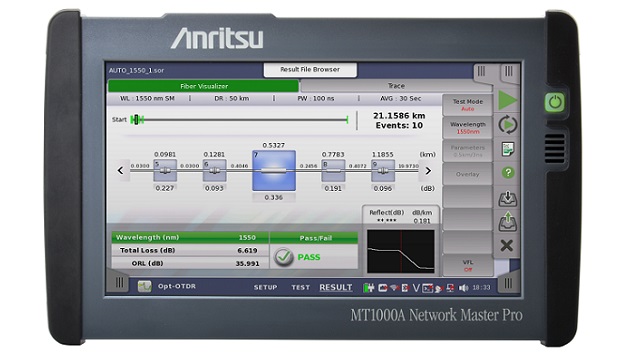Anritsu Corporation is pleased to announce the start of sales of its new MU100023A OTDR*1 Module for the Network Master Pro MT1000A optical network measuring instrument adding triple-wavelength support (1310/1550 nm, 1650 nm SMF) to the existing line of MU100020A/MU100021A/MU100022A modules.
The newly developed MU100023A adds support for the 1650 nm wavelength used for live-fiber evaluations to the 1310/1550 nm wavelengths used for actual communications to enable all-in-one, triple-wavelength OTDR measurements. Like its predecessor MU100020A/MU100021A/MU100022A modules, in addition to having a built-in stabilized light source and optical power meter, the MU100023A features a built-in visual light source and optical fiberscope options. Installing it in the MT1000A offers all-in-one communications quality-inspections of each optical fiber line, as well as live-fiber fault detection.
Additionally, simultaneous installation of the MU100023A in the MT1000A with installed 10G Multirate Module MU100010A and 100G Multirate Module MU100011A supports the above-described measurements plus transmission quality measurements using just one MT1000A.
To support the expected rapid growth in data traffic with the appearance of 5G mobile terminals, both the mobile fronthaul and backhaul*2 network segments are switching to optical signaling with widening adoption of WDM*3 in Metro networks.
With this launch of the MU100023A OTDR module for the MT1000A, Anritsu expects to help increase the efficiency of optical fiber installation and maintenance (I&M) for these above-described networks.
Development Background
The spread of SNS and video-streaming services is creating an explosive increase in data communications by smartphones, tablets, etc., resulting in a need to reinforce mobile backhaul and fronthaul infrastructure. As a consequence, there is growing demand for an OTDR supporting the 1650 nm wavelength for both network installation and live-fiber maintenance evaluation. Network I&M requires both optical fiber quality tests and transmission quality tests, which in turn increases the need for an all-in-one multiplatform supporting these evaluations.
Anritsu already supports transmission quality tests using its Network Master Pro MT1000A and a line of OTDR module options, such as the 10G Multirate Module MU100010A. It also offers the MU100020A/MU100021A/MU100022A modules for optical fiber quality tests.
Today’s announcement adds the newly developed MU100023A OTDR module supporting triple wavelengths (1310/1550 nm, 1650 nm SMF) to the product line and enables one MT1000A unit to support all OTDR and transmission quality tests required for I&M covering mobile to Metro network segments.
Product Outline
The MU100020A/MU100021A/MU100022A/MU100023A line of OTDR modules for the Network Master Pro MT1000A feature a built-in OTDR, stabilized light source, and optical power meter for optical fiber I&M. In addition, a visual light source and optical fiberscope can be added as options to offer the required optical fiber I&M measurement functions in a single module.
The MU100023A built-in filter removes live-fiber wavelength bands other than the 1650 nm maintenance band to support fault finding while remaining connected to live fiber. Like its predecessor MU100020A/MU100021A/MU100022A modules, it offers fast real-time measurements with excellent responsivity, short dead zone*4, and a wide dynamic range*5. Furthermore, the large, 9-inch, high-resolution, full-color touchscreen and easy-to-use Fiber Visualizer function are designed for ease-of-use by operators who are less familiar with OTDR measurements.
Key Features
■ Live-Fiber Maintenance Evaluation using OTDR
The MU100023A supports the 1650 nm wavelength band used for optical fiber maintenance. With a built-in filter to remove wavelength bands used for live-fiber communications it enables both live-fiber testing and fault location as well as dark-fiber tests without live communications.
■ All-in-One OTDR and Transmission Quality Tests
With its wide dynamic range function (1310/1550 nm, 1650 nm: 42/41 dB, 35 dB), the MU100023A OTDR module can be installed simultaneously with the existing 10G Multirate Module MU100010A and 100G Multirate Module MU100011A to offer all-in-one support for fiber fault location and transmission quality tests of mobile fronthaul and backhaul network segments.
■ Intuitive At-a-Glance Fiber Loss and Return Loss Evaluation
The MU100023A has the same Fiber Visualizer function as its predecessor MU100020A/MU100021A/MU100022A modules for easy-to-recognize symbolic characterization of fiber connectors and splices at OTDR measurement. Color-coded pass/fail result evaluations of fault loss and return loss based on set reference values help ease the burden of fiber tests for inexperienced OTDR operators, while PDF reports are created by one-button operation.
■ Higher Fault Detection Accuracy
The MU100020A/MU100021/MU100022A/MU100023A module line implements OTDR measurements while auto-switching measurement conditions to detect faults from compound analysis results and help improve evaluation accuracy for both PON networks*6 and complex circuits composed of long and short fibers.
Target Markets and Applications
■ Target Markets: Mobile operator base station installation contractors, communications engineers, network construction companies, communications infrastructure maintenance companies, communications infrastructure construction companies
■ Applications: Optical network installation and maintenance
Technical Terms
*1 OTDR
Abbreviation for Optical Time Domain Reflectometer; Optical pulse test instrument for measuring optical fiber characteristics (fiber length, loss, connection locations) using laser light
*2 Mobile Fronthaul/Mobile Backhaul
Mobile Fronthaul: Network segment between radio base station and antenna installation
Mobile Backhaul: Wired network segment linking radio base station and nearest exchange
*3 WDM
Abbreviation for Wavelength Division Multiplexing
*4 Dead Zone
One index for evaluating OTDR resolution. In specific terms, the smallest unit of measurable separation between two connected reflection locations, such as connectors. The shorter the dead zone, the more accurate the fiber position location.
*5 Dynamic Range
Index expressing OTDR performance by displaying optical level loss vs distance. Longer optical fibers can be measured as the dynamic range becomes wider.
*6 PON
Abbreviation for Passive Optical Network; technology for adding multiple subscribers to one fiber by inserting fiber splitters into optical network.
For more information, visit: www.anritsu.com

